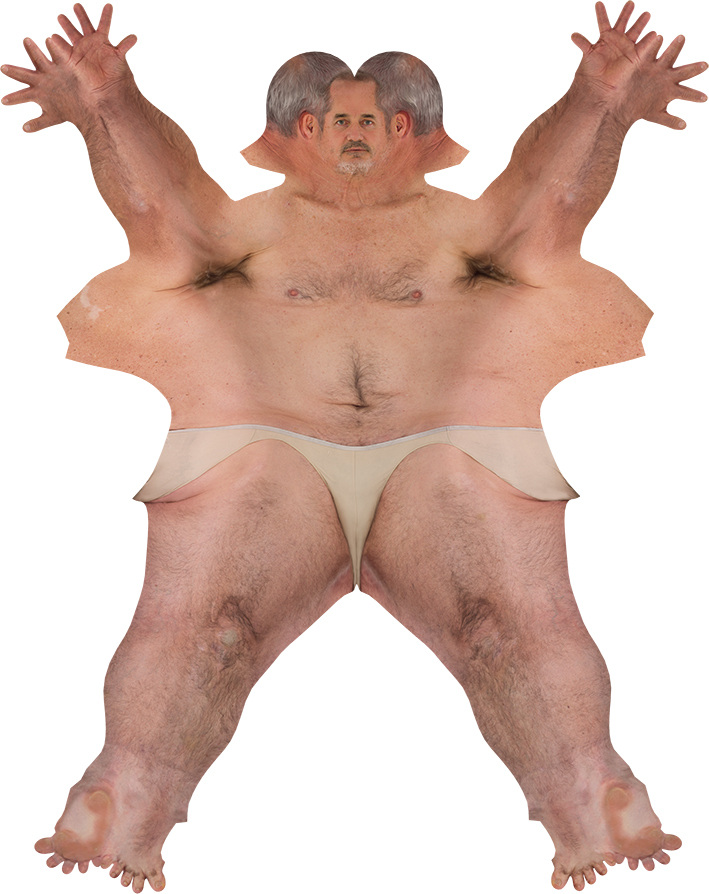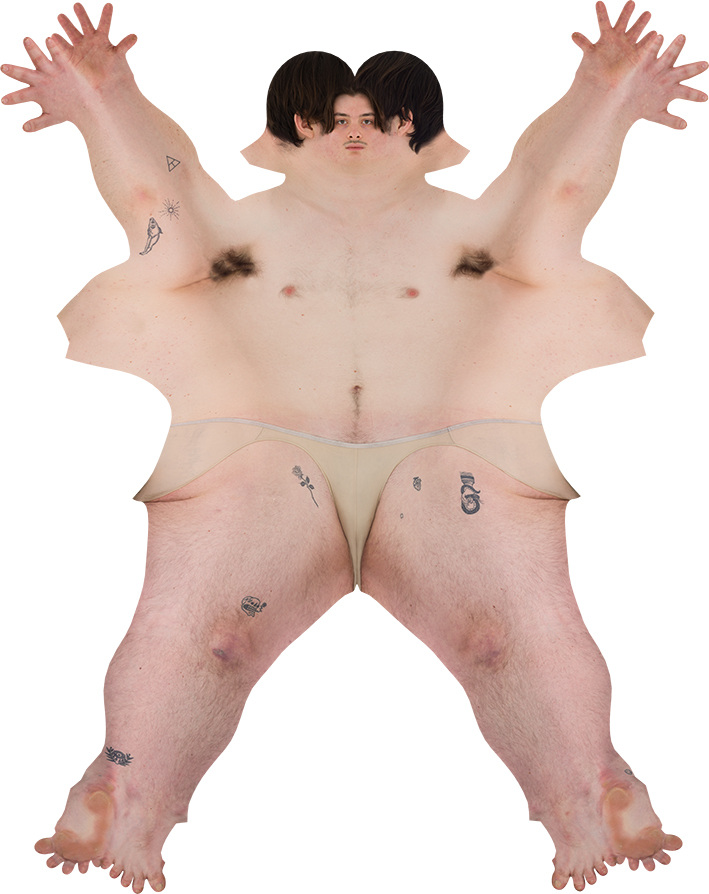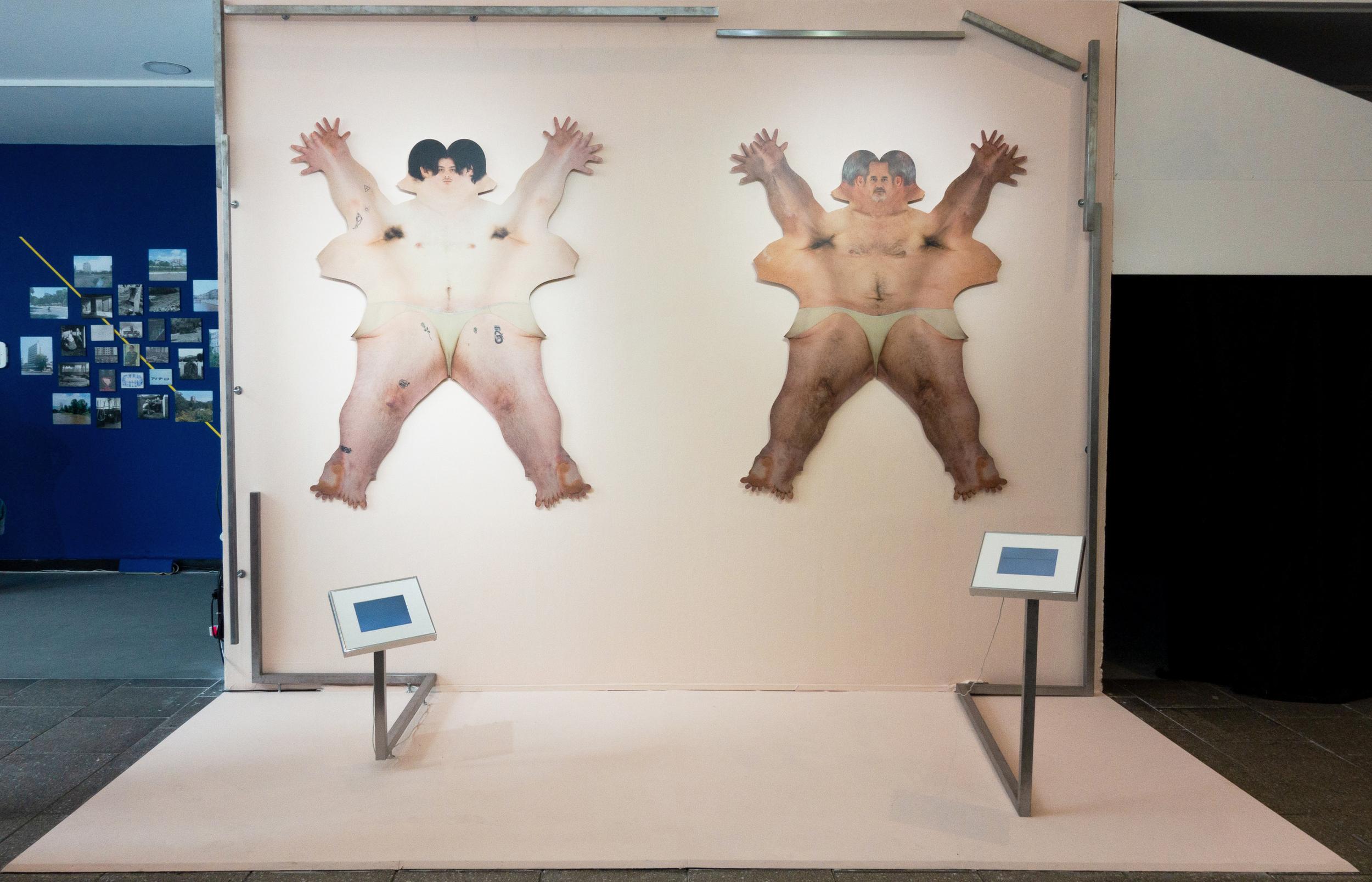C-Type Print, Dibond, Steel, Timber, Aluminium Frames, iPads, Artificial Intelligence
Edition of 3+2AP (2019)
Edition of 3+2AP (2019)




‘Programmed By My Father’ is an installation exploring paternal relationships by investigating the unspoken, between my father and me. The work evolved into a large research project, allowing me to dig deep into complex family dynamics, the fear of growing up and the boundaries between the real and the untold. Through meticulous and obsessive recordings of our conversations, I have created an artificial
intelligence that continuously learns how we communicate, creating its own infinite dialogues based on our interactions as father and son.
In conjunction to this, three- dimensional photographic portraits of my father and me have been produced, laid bare on a two-dimensional plane. By removing the physicality of the human body and the obtrusive bias of being, I am disconnecting myself from our relationship and allowing the digital to take over. For the first time, I can become a spectator to our conversations and I can stand back and experience us—side by side—sheltered from the impossible objectivity of the photographer’s gaze. These three-dimensional images (Pelt I & Pelt II) are left exposed and vulnerable, flattened - without any part of the body left behind.‘Programmed By My Father’ does not function solely as a work of art, but instead as something that will not cease to exist; instead, it will continue to grow. Removing the boundaries between the real and the digital, the conversations I have had with my father will live on as a separate entity, as a collective consciousness.
Slavoj Zizek mentions in his foreword for Henry Bond’s ‘Lacan at the Scene’ that “[when] the voice is subtracted from its “natural” totality of the body to which it belongs, out of which it emerges as an autonomous partial object, an organ which can magically survive without the body” (Bond, H. and Zizek, S. 2016). The work as an installation is an “autonomous partial object” in its own right. Born from flesh, it lives on as its own entity, without “the body whose organ it is — it is as it stands” (sic). With the skin laid bare, the words that have been transformed by lines of code into something new, the wall that has been painted the colour of flesh and the rigid metal structure that frames the work to create a meditative enclosed space - ‘Programmed By My Father’ becomes an organism. A living work that questions a relationship between two humans. It “signals simultaneously a distance and an obscene over-proximity, a presence more intimate, more penetrating, than that of an external body in front of us.” (sic) The work, just like any organism, needs to spread its roots. The flesh-coloured walls and the network of metal structures coarsing through the installation provide a place for the artificial intelligence and the images to interact and coexist and to explore the notions of loss, love, trauma and the fragmented truths of reality.
Having never actually had the conversations that are created throughout the show or laid myself and my father as vulnerable and exposed as in these images, it was important to consider the space that they inhabit. Uprooted from my home at a young age when my parents split up, I have always struggled with calling a place ‘home’. As I take a step back from my relationship with my father, I am able to establish a sense of control by clearly delineating a space which is mine. I am able to assert myself in the work whilst remaining a spectator, creating that border within the walls of the installation that houses the work.In this time where technology takes dystopic forms, where algorithms seem to appropriate the fabric of our humanity and mould us as a function of our worst tendencies, it was important for me to create something that felt human and warm, yet distant in its objective nature. Although abstracted and alien, the machine can parse the hidden vocabulary of the heart and give us an altered lens to view my relationship with my father by allowing the machines to create their own perspective. The machine—if used correctly—can unveil something that is more human than human - something that our subjective ‘flesh computers’ are incapable of comprehending. They are our mirrors, they resemble our minds, our consciousness and occasionally our physicality. We have created them after ourselves, yet their feedback lacks any subjective thought. When human subjectivity is set aside, patterns emerge, lines of code are created and the analysis that comes from them is true and calculated, albeit cold. This is the mechanical gaze, the posthuman eye that objectively scans, records and archives for the subjective. This mechanical gaze judges the colour of your shoes, your walking patterns or the quality of your mobile phone images, but only when set up to do so. It trawls and scours, but only when mandated. It is a tool for introspection, to better understand the fabric of our human condition, yet it is completely non-human. It is void of any emotions - simply a vessel waiting for commands. The work became meditative, the process was one of introspection - just as much as the final outcome.
A photograph was never enough, it was too much a part of me and too much a part of my father. It felt more voyeuristic than a full body scan. It felt as though I was forcing my understanding of this work onto itself. The machine gaze was needed to level the playing field. In the words of ScanLabprojects, creating these three-dimensional scans allow us to view the subject not from a single perspective, but as a whole. As a ‘Watkins’, as a ‘Weed’, as an ‘Adams’ and as every single other image that precedes them. Although the work is strange and unnerving and the AI feels cold and distant, one recognises something human in it. This work, although created by a machine, by lines of code and stitched together from multiple realities, is composed for the human eye - for what Trevor Paglen calls ‘meat-eyes’ as opposed to the aloof vision of a machine. It is important to understand that anything meant for ‘meat-eyes’ Abrams, L. (2017) are depictions that carry a heavy baggage. They lug around the weight of the subjectivity of being human. Through ‘Programmed By My Father’, I purposefully relinquish control—be it artistically or physically—allowing both my father and me to become absent from the relationship that we share, becoming spectators in our own game, thus creating a space for reflection and mutual understanding.Having been unable to understand complicated family relationships throughout the years, ‘Programmed By My Father’ became a desperate attempt at turning to the machine’s gaze to unveil what had been lost, forgotten and buried. The work itself became an instrument to observe the world anew, to witness what is hidden, a viewing device - glasses of their own. Leaving me both free and vulnerable, the body of work gave birth to something from the ground up. Just as outside factors affect the process of who we become as people and everything we do, this work is imbued by my father and me. We fed it our relationship, to create a new single entity - a single consciousness that is an amalgam of everything in between.
In conjunction to this, three- dimensional photographic portraits of my father and me have been produced, laid bare on a two-dimensional plane. By removing the physicality of the human body and the obtrusive bias of being, I am disconnecting myself from our relationship and allowing the digital to take over. For the first time, I can become a spectator to our conversations and I can stand back and experience us—side by side—sheltered from the impossible objectivity of the photographer’s gaze. These three-dimensional images (Pelt I & Pelt II) are left exposed and vulnerable, flattened - without any part of the body left behind.‘Programmed By My Father’ does not function solely as a work of art, but instead as something that will not cease to exist; instead, it will continue to grow. Removing the boundaries between the real and the digital, the conversations I have had with my father will live on as a separate entity, as a collective consciousness.
Slavoj Zizek mentions in his foreword for Henry Bond’s ‘Lacan at the Scene’ that “[when] the voice is subtracted from its “natural” totality of the body to which it belongs, out of which it emerges as an autonomous partial object, an organ which can magically survive without the body” (Bond, H. and Zizek, S. 2016). The work as an installation is an “autonomous partial object” in its own right. Born from flesh, it lives on as its own entity, without “the body whose organ it is — it is as it stands” (sic). With the skin laid bare, the words that have been transformed by lines of code into something new, the wall that has been painted the colour of flesh and the rigid metal structure that frames the work to create a meditative enclosed space - ‘Programmed By My Father’ becomes an organism. A living work that questions a relationship between two humans. It “signals simultaneously a distance and an obscene over-proximity, a presence more intimate, more penetrating, than that of an external body in front of us.” (sic) The work, just like any organism, needs to spread its roots. The flesh-coloured walls and the network of metal structures coarsing through the installation provide a place for the artificial intelligence and the images to interact and coexist and to explore the notions of loss, love, trauma and the fragmented truths of reality.
Having never actually had the conversations that are created throughout the show or laid myself and my father as vulnerable and exposed as in these images, it was important to consider the space that they inhabit. Uprooted from my home at a young age when my parents split up, I have always struggled with calling a place ‘home’. As I take a step back from my relationship with my father, I am able to establish a sense of control by clearly delineating a space which is mine. I am able to assert myself in the work whilst remaining a spectator, creating that border within the walls of the installation that houses the work.In this time where technology takes dystopic forms, where algorithms seem to appropriate the fabric of our humanity and mould us as a function of our worst tendencies, it was important for me to create something that felt human and warm, yet distant in its objective nature. Although abstracted and alien, the machine can parse the hidden vocabulary of the heart and give us an altered lens to view my relationship with my father by allowing the machines to create their own perspective. The machine—if used correctly—can unveil something that is more human than human - something that our subjective ‘flesh computers’ are incapable of comprehending. They are our mirrors, they resemble our minds, our consciousness and occasionally our physicality. We have created them after ourselves, yet their feedback lacks any subjective thought. When human subjectivity is set aside, patterns emerge, lines of code are created and the analysis that comes from them is true and calculated, albeit cold. This is the mechanical gaze, the posthuman eye that objectively scans, records and archives for the subjective. This mechanical gaze judges the colour of your shoes, your walking patterns or the quality of your mobile phone images, but only when set up to do so. It trawls and scours, but only when mandated. It is a tool for introspection, to better understand the fabric of our human condition, yet it is completely non-human. It is void of any emotions - simply a vessel waiting for commands. The work became meditative, the process was one of introspection - just as much as the final outcome.
A photograph was never enough, it was too much a part of me and too much a part of my father. It felt more voyeuristic than a full body scan. It felt as though I was forcing my understanding of this work onto itself. The machine gaze was needed to level the playing field. In the words of ScanLabprojects, creating these three-dimensional scans allow us to view the subject not from a single perspective, but as a whole. As a ‘Watkins’, as a ‘Weed’, as an ‘Adams’ and as every single other image that precedes them. Although the work is strange and unnerving and the AI feels cold and distant, one recognises something human in it. This work, although created by a machine, by lines of code and stitched together from multiple realities, is composed for the human eye - for what Trevor Paglen calls ‘meat-eyes’ as opposed to the aloof vision of a machine. It is important to understand that anything meant for ‘meat-eyes’ Abrams, L. (2017) are depictions that carry a heavy baggage. They lug around the weight of the subjectivity of being human. Through ‘Programmed By My Father’, I purposefully relinquish control—be it artistically or physically—allowing both my father and me to become absent from the relationship that we share, becoming spectators in our own game, thus creating a space for reflection and mutual understanding.Having been unable to understand complicated family relationships throughout the years, ‘Programmed By My Father’ became a desperate attempt at turning to the machine’s gaze to unveil what had been lost, forgotten and buried. The work itself became an instrument to observe the world anew, to witness what is hidden, a viewing device - glasses of their own. Leaving me both free and vulnerable, the body of work gave birth to something from the ground up. Just as outside factors affect the process of who we become as people and everything we do, this work is imbued by my father and me. We fed it our relationship, to create a new single entity - a single consciousness that is an amalgam of everything in between.